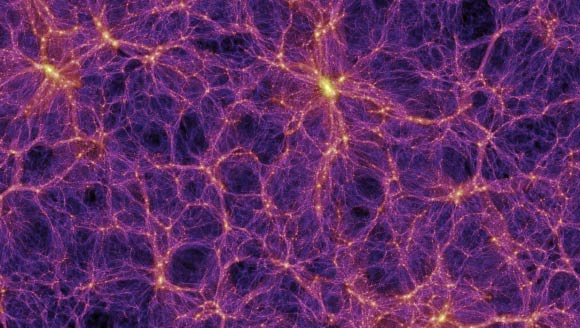A new study by the University of Wisconsin-Madison supports the idea that our Milky Way Galaxy and its neighbors exist in one of the holes, or voids, of the large-scale structure of the cosmos.

This image portrays a simulation of the Universe. Each of the tiniest of the dots denotes an entire galaxy. Matter in the Universe is arrayed on a series of filaments that surround vast voids. Image credit: Max Planck Institute for Astrophysics.
In 2013, University of Wisconsin-Madison astronomer Dr. Amy Barger and co-authors showed that the Milky Way resides in a fascinating two-billion light-year wide void, called the KBC void.
Their new study not only firms up this idea, but helps ease the apparent disagreement or tension between different measurements of the Hubble constant.
The tension arises from the realization that different techniques astrophysicists employ to measure how fast the Universe is expanding give different results.
“No matter what technique you use, you should get the same value for the expansion rate of the Universe today. Fortunately, living in a void helps resolve this tension,” said Benjamin Hoscheit, a student at the University of Wisconsin-Madison.
The reason for that is that a void — with far more matter outside the void exerting a slightly larger gravitational pull — will affect the Hubble constant value one measures from a technique that uses relatively nearby supernovae, while it will have no effect on the value derived from a technique that uses the Cosmic Microwave Background (CMB).
The new study is part of the much bigger effort to better understand the large-scale structure of the Universe.
The structure of the cosmos is Swiss cheese-like in the sense that it is composed of ‘normal matter’ in the form of voids and filaments.
The filaments are made up of superclusters and clusters of galaxies, which in turn are composed of stars, gas, dust and planets.
Dark matter and dark energy, which cannot yet be directly observed, are believed to comprise 95% of the contents of the Universe.
The KBC void is at least 7 times as large as the average. To date, it is the largest void known to science.
The new analysis shows that the team’s first estimations of the KBC void, which is shaped like a sphere with a shell of increasing thickness made up of galaxies, stars and other matter, are not ruled out by other observational constraints.
“It is often really hard to find consistent solutions between many different observations,” Dr. Barger said.
The bright light from a supernova explosion, where the distance to the galaxy that hosts the supernova is well established, is the ‘candle’ of choice for astronomers measuring the accelerated expansion of the Universe.
Because those objects are relatively close to the Milky Way and because no matter where they explode in the observable Universe, they do so with the same amount of energy, it provides a way to measure the Hubble constant.
Alternatively, the CMB is a way to probe the very early Universe.
“Photons from the CMB encode a baby picture of the very early Universe,” Hoscheit said.
“They show us that at that stage, the Universe was surprisingly homogeneous. It was a hot, dense soup of photons, electrons and protons, showing only minute temperature differences across the sky. But, in fact, those tiny temperature differences are exactly what allow us to infer the Hubble constant through this cosmic technique.”
“A direct comparison can thus be made between the ‘cosmic’ determination of the Hubble constant and the ‘local’ determination derived from observations of light from relatively nearby supernovae,” he said.
“The new analysis shows that there are no current observational obstacles to the conclusion that the Milky Way resides in a very large void,” Dr. Barger said.
“As a bonus, the presence of the void can also resolve some of the discrepancies between techniques used to clock how fast the Universe is expanding.”
Hoscheit and colleagues reported their findings June 6, 2017 at the 230th Meeting of the American Astronomical Society in Austin, Texas.
_____
Benjamin L. Hoscheit & Amy J. Barger. 2017. Large Local Void, Supernovae Type Ia, and the Kinematic Sunyaev-Zel’dovich Effect in a Lambda-LTB Model. 230th AAS Meeting Abstracts, abstract # 314.05







